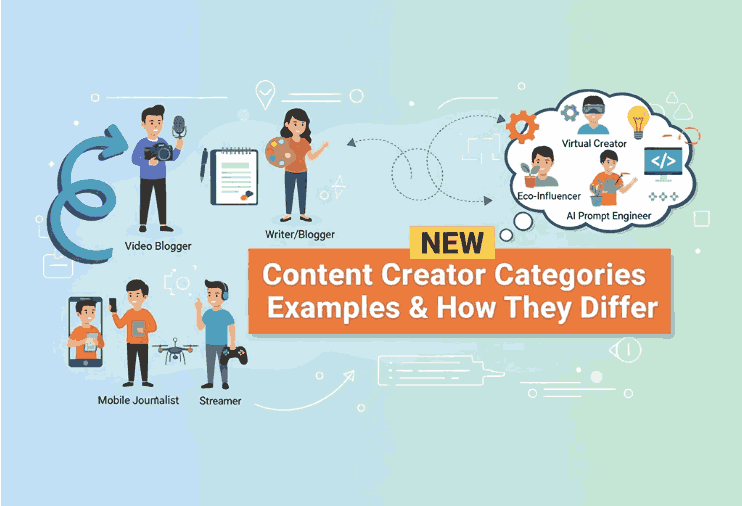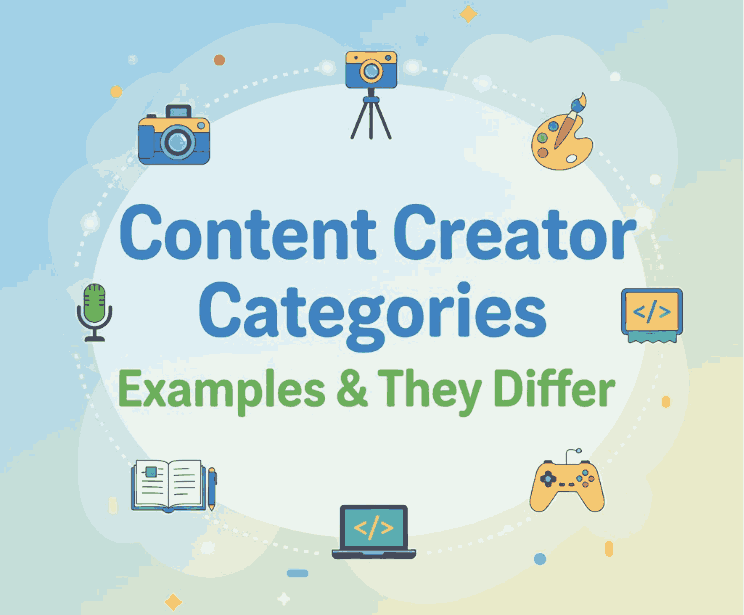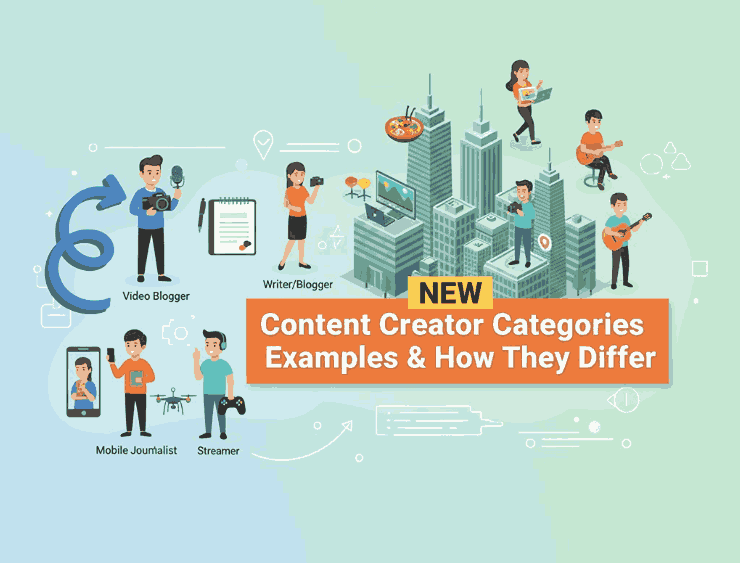
Table of Contents
- Introduction
- Why Knowing Creator Categories Matters
- Core Content Creator Categories & Examples
- 3.1 Video / Visual Creators
- 3.2 Writers / Bloggers / Text Creators
- 3.3 Podcasters & Audio Creators
- 3.4 Educators / Course Creators
- 3.5 Influencers & Brand Ambassadors
- 3.6 UGC / Community Creators
- 3.7 Designers, Digital Artists & Visual Specialists
- Blended & Hybrid Creator Types
- How Font & Design Businesses Fit In
- Font Mockup Examples to Showcase in Diverse Creator Niches
- How to Choose or Express Your Own Creator Category
- Conclusion & Action Guide
- References
1. Introduction Content Creator Categories Examples
In the vast creator economy, not all content creators do the same work or speak with the same voice. Understanding content creator categories examples helps you clarify your niche, collaborate smartly, and communicate your value clearly.
For a business centered on fonts and design, recognizing these creator types helps you align your products (fonts, mockups, templates) with the right audiences and creative partnerships.
2. Why Knowing Content Creator Categories Examples
Matters
- Better alignment: You can tailor your products or offerings to the needs of each category.
- Effective partnerships: You know which creators to approach for collaborations (e.g. a video creator vs a blogger).
- Stronger branding: When you know your type (or your clients’ types), you can position your visual identity more deliberately.
- Diverse revenue paths: Each category often monetizes differently.
Refer to Shopify’s “7 types of digital creators” for archetypes and how they work: Performer, Maker, Technophile, etc.

3. Core Content Creator Categories Examples
Here are several major categories of content creators, together with real-world examples of how they operate and how fonts/design interplay with them:
3.1 Video / Visual Creators
These creators primarily produce video content, motion graphics, visual storytelling, or photo-based content. Think YouTubers, TikTokers, cinematographers, visual storytellers.
- Their content demands strong visuals, typography, and motion design.
- Font needs: dynamic, legible on video, expressive overlays.
3.2 Writers / Bloggers / Text Creators
These creators focus on producing textual content: articles, essays, blog posts, long-form narratives.
- They may use imagery and typographic elements to enhance readability.
- They often rely on well-paired fonts for headers, body text, callouts.
3.3 Podcasters & Audio Creators
Audio-first creators produce spoken-word content, interviews, storytelling, and often repurpose into video. Their written assets (episode titles, social promos) benefit from strong visual design.
3.4 Educators / Course Creators
These creators package their knowledge into classes, workshops, tutorial videos, written guides, and courses. They often need slide decks, resource materials, PDF workbooks, and branding.
3.5 Influencers & Brand Ambassadors
Influencers use a personal brand to share opinions, reviews, lifestyle or niche content—often collaborating with brands. They produce multi-format content (video, posts, stories).
- Their content tends to emphasize strong visual branding and fonts that reflect their persona.
3.6 UGC / Community Creators
User-generated content (UGC) creators produce content around everyday experiences, testimonials, or small-scale creative repurposing. Brands often engage them for authentic content.
They often remix visuals, overlays, and typography.
3.7 Designers, Digital Artists & Visual Specialists
These creators are often skilled in visual arts — illustration, graphic design, UI/UX, motion design. They create visual assets, templates, mockups, design experiments.
- A font business aligns naturally with this group. They demand premium fonts, variable fonts, unique styles, type pairing guidance.
Teleprompter.com lists designers and visual creators as a major category.
Also, Hurrdat marketing mentions bloggers, photographers, graphic designers among content creator types.
4. Blended & Hybrid Content Creator Categories Examples
Types
Many creators don’t fit a single category. They blend:
- A podcaster + video creator
- A designer + educator who sells courses about design
- An influencer + UGC creator who makes everyday content along with brand collaborations
These hybrid creators benefit from cross-format fluency and can reach multiple audiences.
5. How Font & Design Businesses Fit In
As a font shop and design asset provider, you can serve many creator categories:
- Video creators: provide fonts optimized for video subtitles, motion designs, title overlays.
- Educators / course creators: supply fonts for slides, workbooks, handouts.
- Influencers / UGC creators: offer branded fonts or type kits they can integrate in social visuals.
- Designers / visual creators: collaborate on font development, license custom versions, co-create templates.
Understanding creator categories helps you package your fonts with appropriate mockups, bundles, and usage examples.
6. Font Mockup Examples to Showcase in Diverse Content Creator Categories Examples Niches
Here are some fonts from your collection and mockup ideas suited to different creator types:
- Aeromove Font — use in video title overlays or motion typography demos for video creators.
- Aulion Font Duo — pair for header/body combos in blog posts or course slides.
- Salvations Font — dramatic and expressive, good for influencer branding graphics.
- Daylighted — sleek modern style for UI mockups, visual designers, or minimalist layouts.
In each mockup, you can show how the font works in the context of a creator’s output: video thumbnail, slide deck, social post, or design portfolio.

7. How to Choose or Express Your Own Content Creator Categories Examples
- Identify your primary medium: video, writing, audio, design?
- Recognize your strength: storytelling, visuals, education, personality.
- Lean into what you enjoy: hybrid creators often burn out — better to focus where your passion and skill lie.
- Adapt and evolve: many creators shift categories as their audience or monetization changes.
- Communicate clearly: state your creator type in your brand messaging, so clients/audience know what you do best.
8. Conclusion & Action Guide Content Creator Categories Examples
Understanding content creator categories examples empowers you to:
- Tailor your offerings (fonts, templates) to different creator types
- Position yourself for collaborations
- Clarify your niche and brand identity
Action Steps:
- Pick one or two creator types that align with your strengths.
- Create mockups and resources tailored to those categories.
- Showcase those mockups in your marketing (blog, social, portfolio).
- Reach out to creators in those categories for partnership or feedback.
With clarity and purpose, your font business can better engage creators, serve their needs, and grow together.
References
- Kit Blog — “Types of Content Creators”
- Hurrdat Marketing — “11 Common Types of Content Creators in 2024”
- Shopify — “7 Types of Digital Creators Who Power the Creator Economy”
- ClickUp — “Different Types of Content Creators on Social Media Platforms”



